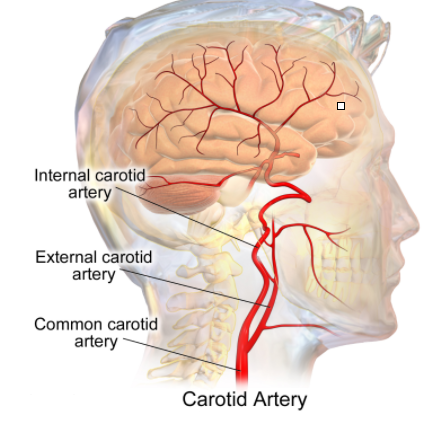
Where exactly is the Carotid artery located?
Answer
472.2k+ views
Hint: An artery is a type of blood vessel that transports blood from the heart to one or more parts of the body (tissues, lungs, brain, etc.). The pulmonary and umbilical arteries, which carry deoxygenated blood to the organs that oxygenate it, are the two exceptions to this rule (lungs and placenta, respectively). The extracellular fluid that fills the arterial system is referred to as the effective arterial blood volume.
Complete answer:
The arteries are part of the circulatory system, which is in charge of delivering oxygen and nutrients to all cells, as well as removing carbon dioxide and waste products, maintaining optimal blood pH, and circulating proteins and immune system cells.
The common carotid arteries can be found on both the left and right sides of the body. These arteries branch off from other arteries but take symmetrical paths. The right common carotid begins in the neck from the brachiocephalic trunk, while the left begins in the thorax from the aortic arch. At the upper border of the thyroid cartilage, around the fourth cervical vertebra, these split into the external and internal carotid arteries.
The common carotid artery is frequently used in pulse measurement, particularly in patients who are in shock and have no detectable pulse in the more peripheral arteries of the body. Palpating the artery just deep to the anterior border of the sternocleidomastoid muscle at the level of the superior border of the thyroid cartilage yields the pulse.

Thus, The carotid arteries are blood vessels found on both the left and right sides of the neck. The carotid arteries transport blood to the brain and head.
Note: The common carotid artery is frequently used in pulse measurement, particularly in patients who are in shock and have no detectable pulse in the more peripheral arteries of the body. Palpating the artery just deep to the anterior border of the sternocleidomastoid muscle at the level of the superior border of the thyroid cartilage yields the pulse.
Complete answer:
The arteries are part of the circulatory system, which is in charge of delivering oxygen and nutrients to all cells, as well as removing carbon dioxide and waste products, maintaining optimal blood pH, and circulating proteins and immune system cells.
The common carotid arteries can be found on both the left and right sides of the body. These arteries branch off from other arteries but take symmetrical paths. The right common carotid begins in the neck from the brachiocephalic trunk, while the left begins in the thorax from the aortic arch. At the upper border of the thyroid cartilage, around the fourth cervical vertebra, these split into the external and internal carotid arteries.
The common carotid artery is frequently used in pulse measurement, particularly in patients who are in shock and have no detectable pulse in the more peripheral arteries of the body. Palpating the artery just deep to the anterior border of the sternocleidomastoid muscle at the level of the superior border of the thyroid cartilage yields the pulse.

Thus, The carotid arteries are blood vessels found on both the left and right sides of the neck. The carotid arteries transport blood to the brain and head.
Note: The common carotid artery is frequently used in pulse measurement, particularly in patients who are in shock and have no detectable pulse in the more peripheral arteries of the body. Palpating the artery just deep to the anterior border of the sternocleidomastoid muscle at the level of the superior border of the thyroid cartilage yields the pulse.
Recently Updated Pages
The number of solutions in x in 02pi for which sqrt class 12 maths CBSE

Write any two methods of preparation of phenol Give class 12 chemistry CBSE

Differentiate between action potential and resting class 12 biology CBSE

Two plane mirrors arranged at right angles to each class 12 physics CBSE

Which of the following molecules is are chiral A I class 12 chemistry CBSE

Name different types of neurons and give one function class 12 biology CBSE

Trending doubts
One Metric ton is equal to kg A 10000 B 1000 C 100 class 11 physics CBSE

Explain zero factorial class 11 maths CBSE

What is 1s 2s 2p 3s 3p class 11 chemistry CBSE

Discuss the various forms of bacteria class 11 biology CBSE

State the laws of reflection of light

Difference Between Prokaryotic Cells and Eukaryotic Cells




